
Taylor Bearden
Civico Development
For Taylor Bearden, Partner at Civico Development, real estate is the stage upon which urban life plays out, with each individual structure contributing to a rich tapestry that ultimately determines the quality of our lives and the health of our neighborhoods and communities.

By Erin Clark for Commonplace
Can you briefly introduce yourself and your background?
My name is Taylor Bearden. I'm a Partner at Civico Development, which was founded in 2015 by my business partner, Andrew Consigli, who was a career architect and urban planner.
I was born and raised in interior Alaska. I moved around a bit as a young person, but eventually I found my way to Worcester, Massachusetts for college, where I’m still based today. I came here knowing very little, having never really been to New England other than to visit some colleges, but I instantly became enamored with the history and complexity of the built environment here.
This seems obvious, but New England has a lot of old building stock; I really didn’t have any experience with that back in Alaska because my city – insofar as you could even call it a city – was built in the contemporary era. After living here for a little while, I began to see Worcester as a historic, layered city contending with changing times. And with that change came new and interesting complexities, conflicts, and opportunities that would play out in the built environment.
Following that line of thinking, I ended up studying geography, entrepreneurship, and community development and planning in college. To me, those subjects, particularly geography, were really about the interaction of people and place and it was the perfect academic backdrop to shape my understanding of real estate as the stage upon which we play out urban life. Even if it's civic infrastructure, like roads or pipes, everything in our built environment is underpinned by a complex web of contracts, easements, zoning and their interactions with business considerations, like financing and construction costs.
Shortly after I graduated, I met Andrew and we started working together. We found that we both tended to contextualize real estate as the incremental development of neighborhoods over time and our business evolved from that shared understanding.
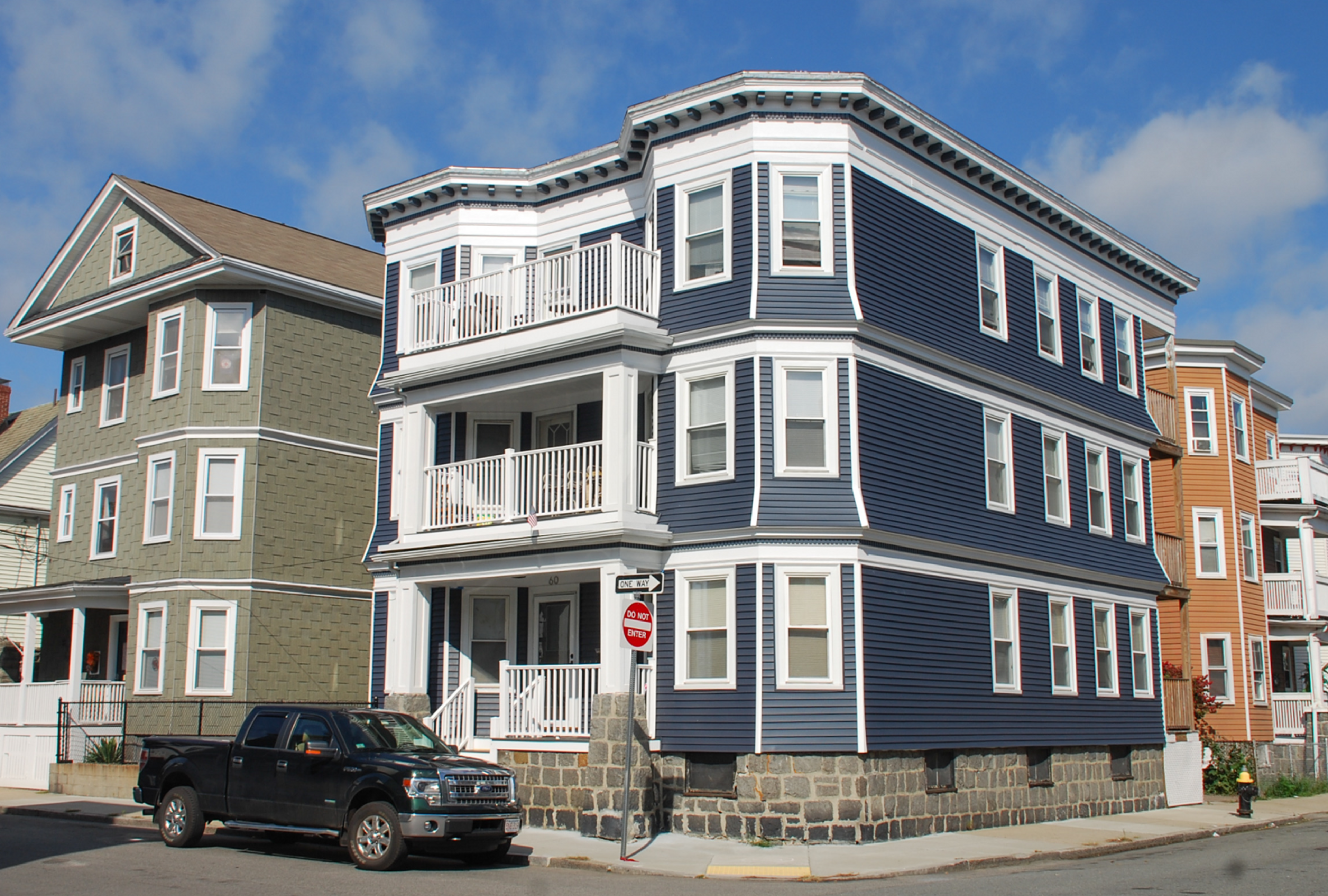
An example of a triple-decker home
Courtesy of the Association of Bay Area Governments
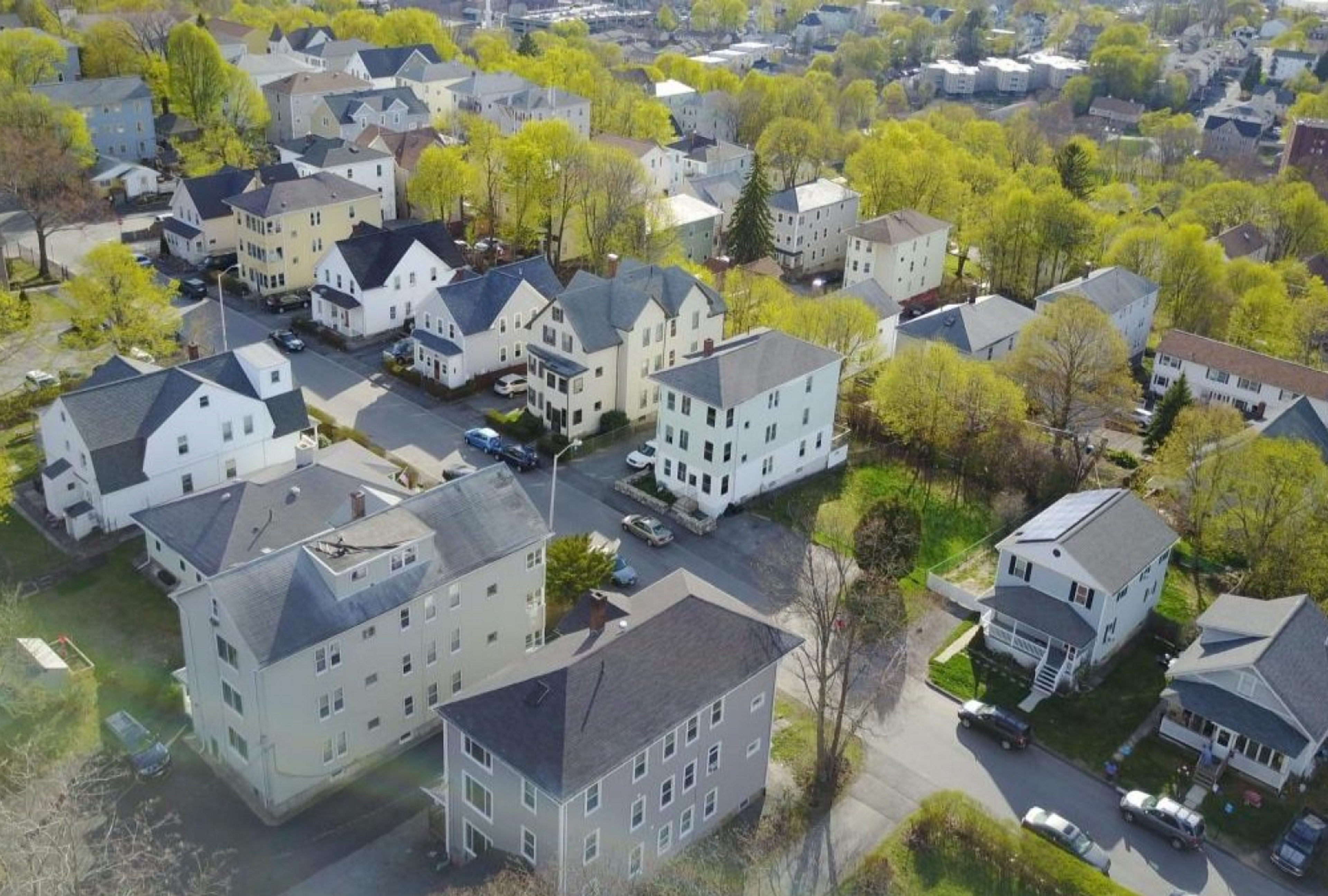
An aerial view of Civico's Bell Hill Neighborhood Revitalization project
Courtesy of Civico Development
How did you find your way into real estate from that initial academic and personal interest?
Like I said, my studies provided me with the academic background for real estate, but the business piece came when I got a job managing properties while still in school. I realized that there was a captive tenant base at my university and that there were landlords needing access to that tenant pool, which created a lot of opportunities. I had also grown up in a construction family and had a modicum of skill, so it was natural putting that to work. I became increasingly embedded in real estate over time and I ended up buying a short sale house, which I worked on and rented out to my friends while I was in college. I also began connecting with the local real estate investment community and building up my relationships little by little.
After I graduated, I worked for a local student housing developer on small-to-medium sized deals, mostly buying, renovating, and renting out three- or four-unit properties to students. I did that for a few years, learning the ropes of small multifamily property management. It was kind of a high pressure – and very, very messy – business because you're dealing with old housing stock without the scale to justify significant infrastructure in a niche filled with fairly unsophisticated operators. However, by going through that exercise, I learned a ton about real estate and built important foundational skills early in my career. It also taught me that I wasn’t really interested in career landlording and property management because, although it served a necessary purpose, it didn't have that impact that I was seeking.
So, while I was still working there, I started to think about investing in some of the triple-deckers that made up the majority of Worcester’s neighborhood housing stock. For those unfamiliar with the term, triple-deckers are a classic architectural style found in Gateway Cities* in Massachusetts and throughout New England. In Worcester, there are about 5,000 of these wood frame homes that were built between 1890 and 1930, many of which are now significantly decayed. And, even though they’re the most common type of housing here, there hasn’t been a real policy lever or development innovation that has enabled them to stay as relevant as they once were, back when this was a growing city in the late 19th and early 20th centuries. That led me to the idea to treat these properties as a collective, rather than as individual buildings, and to consider how to invest in them in a way that might ensure the vitality of entire neighborhoods of triple-deckers. Chasing that question down is what led me to eventually connect with my current business partner and others in the local real estate community.
In late 2016, Andrew Consigli, Albert LaValley, the president of Sustainable Comfort, a green building consulting firm, and I sat down at one of Albert’s restaurants for a conversation. We wanted to figure out a way to build more sustainable housing and package it in a way that would be desirable to a broader investor audience. Between us three, we had a solid and well-rounded set of skills: Andrew was an architect and developer, Albert was an energy efficiency expert, and I had a lot of property management and small multifamily development experience. We decided that the best approach would be to go out, find a building, and try to do a better job than the market was expecting as a way to test that hypothesis ourselves.
We ended up raising a $7 million equity fund around the idea of incremental neighborhood development focused on energy efficiency and sustainability in some of Worcester’s neighborhoods. Between 2017 and 2020, we purchased about 20 properties concentrated in one neighborhood and focused on using what we call deep energy retrofit triggers to create much more sustainable housing for the unsubsidized middle market. Then, after that fund closed, we ended up raising a second fund with a slightly different strategy, deploying all the learnings we gained in a new fund, capital structure, and strategy. However, it was obviously a whole new world in 2020 and 2021 and we had to make a couple deviations from the path.
Along the way, I bought and grew a property management company and I also worked for Albert at his green building company. Ultimately, Andrew and I decided that the future we both wanted was in Civico, establishing ourselves as a design-focused development company specializing in mixed-income and affordable housing production.
* Gateway Cities are an official designation in Massachusetts referring to municipalities with a population between 35,000 and 250,000, an average household income below the state average, and an average educational attainment rate (bachelor's degree or above) below the state average. They are midsize urban centers that anchor regional economies around the state and were historically home to industries that offered residents good jobs and a “gateway” to the American Dream.

By Erin Clark for Commonplace
Can you give me an overview of your company and its mission? How is that mission reflected in your approach to development?
Sure. I’ll start by saying that although we are developers and the product that we make is real estate, I prefer to think of what we do as full stack neighborhood development. That's a phrase that I'm borrowing from a different industry, but in this context what I mean is that the building itself is just one part of why we're interested in the built environment.
There are a lot of communities like ours throughout New England, where real estate development isn't necessarily a given; there may not be a lot of new infill, or local market forces don't support development and investment. Communities like this require a much more holistic view of real estate development and you have to be able to connect the dots between real estate and what might traditionally fall outside of that bucket. So, yes, while we have a competency in development, permitting, acquisition, and financing, we think of real estate more in the context of how our buildings contribute to a better, more sustainable, and more inclusive experience for a community over the course of their useful lives.
You can see that philosophy embedded in our name. We're very civic-minded and we often think of ourselves as facilitators more than anything else; our job is to take disparate groups who have potentially aligned interests and show them how we can manifest those shared visions in the community. That approach is reflected in our pipeline and track record, which consists of a whole lot of different types of work. Different communities need and ask for different things, so to date we’ve worked on luxury condominiums, supportive housing for the homeless, and public-private partnerships for mixed-income housing, just to name a few. And how that works in practice is we build our teams and concepts around a project, as opposed to developing a project that we’re really good at and copying and pasting it across many different communities. The end result is that each of our projects contributes in an organic way to the incremental development of its surrounding neighborhood.

Gateway Cities like Worcester were historically home to industries that offered residents good jobs and a “gateway” to the American Dream
By Erin Clark for Commonplace
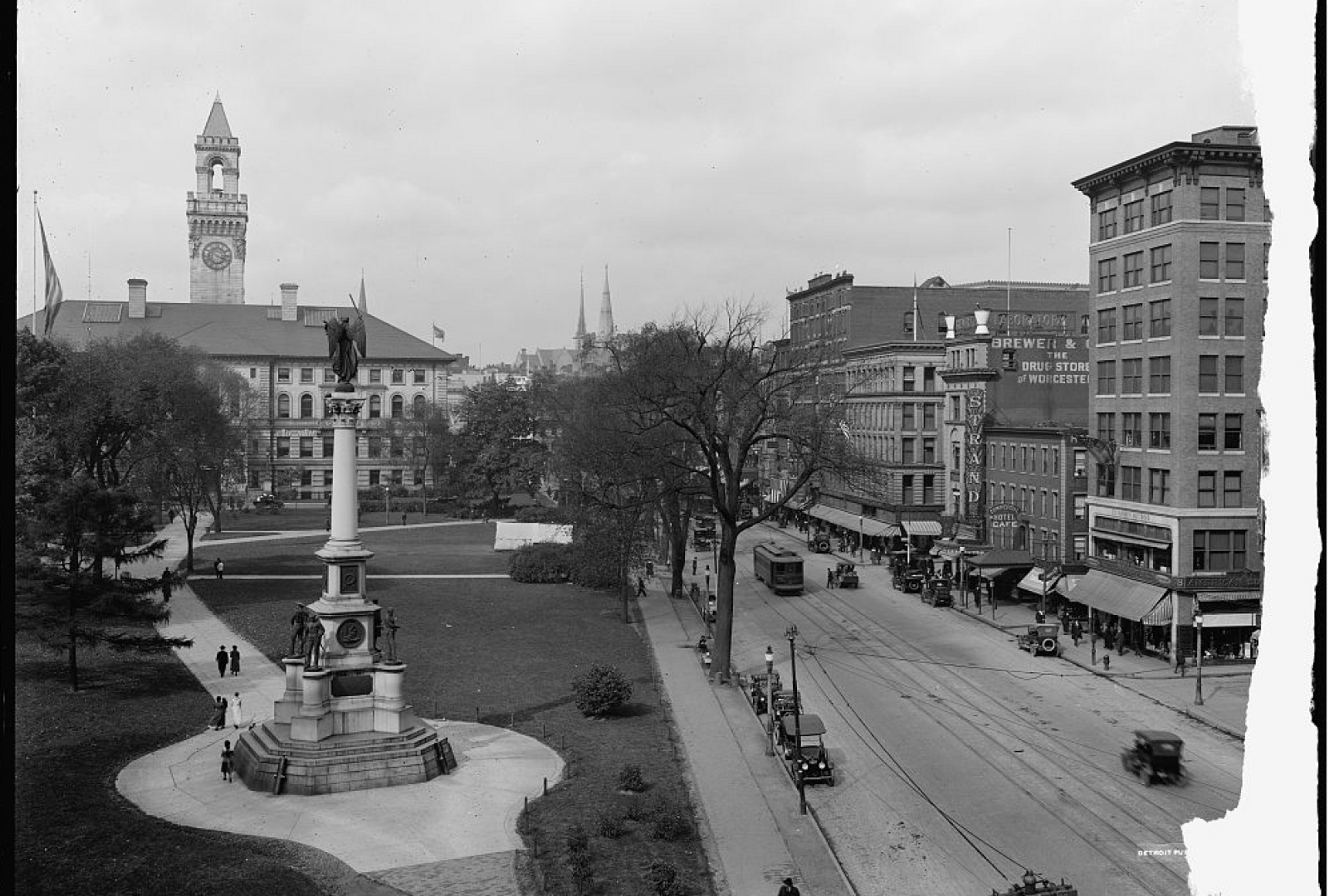
A historic photo of Worcester Common and City Hall taken along Front Street between 1910 and 1920
Courtesy of the Library of Congress
Can you provide an example of a project that you believe best represents that philosophy and approach?
I'll give you two examples of projects that I think are really reflective of our mission, who we are, who we want to be, and who we want to work with.
First, I'm sitting outside my office in a neighborhood called Main South in the city of Worcester – which is actually where I went to college, so there are a number of reasons why I personally care a lot about the area. Here we're working on a multi-phase mixed-income housing development, which consists of five contiguous mills scattered across the site. We'll be producing a total of about 115 housing units, leveraging a wide range of funds, including Low Income Housing Tax Credits, state and federal Historic Tax Credits, local subsidies, as well as private equity, depending on the project phase we're talking about.
I look at that project as a catalyst for the surrounding neighborhood in several different ways. First, the landscape of manufacturing has changed such that the buildings have become less useful for their original industrial purposes, so we're working with the property owner on an exit strategy for his multi-generational family business. Second, to prevent the property from lying fallow and help transition those buildings into valuable assets for the community, we’re creating affordable and mixed-income housing. And finally, we're simultaneously working with the current tenant on site, a local food justice nonprofit, to help them take long-term ownership of their land, so that they can further develop their programming and expand their urban farm.
In this way, the housing component is supporting the other project uses and benefits. There are a lot of resources for developing housing, so the questions become, “How can we take those resources and make sure every dollar brought into the project doesn't just produce $1 of output?” and “How can we use the housing to support other stakeholders who don't necessarily have the same access to resources or a focus on housing production?” This is really what I’m getting at when I talk about full stack development.
I'll segue to a different example, which I think is similar in that way. We were just designated by the Boston Planning & Development Agency (BPDA) earlier this spring to build 33 workforce condominium units that will sit atop a 19,000 square foot future branch of the Boston Public Library. For context, in the city, the Mayor's Office of Housing has an initiative called Housing with Public Assets, which looks at ways to take spaces like libraries or other civic spaces and build housing over the top, while incentivizing developers to deliver a new core and shell for the public asset. So, of course, we threw our hat in the ring because anytime there's a complicated, exciting project like that we're there and eager to articulate a vision that might work.
We’re very proud to be delivering a project that will meet the goals of the community. The first obvious benefit is that there will be a brand-new library branch. But also, because we’re building housing over this very important civic space, we’ll be helping to increase the cohesion between local residents and the civic spaces in their community.
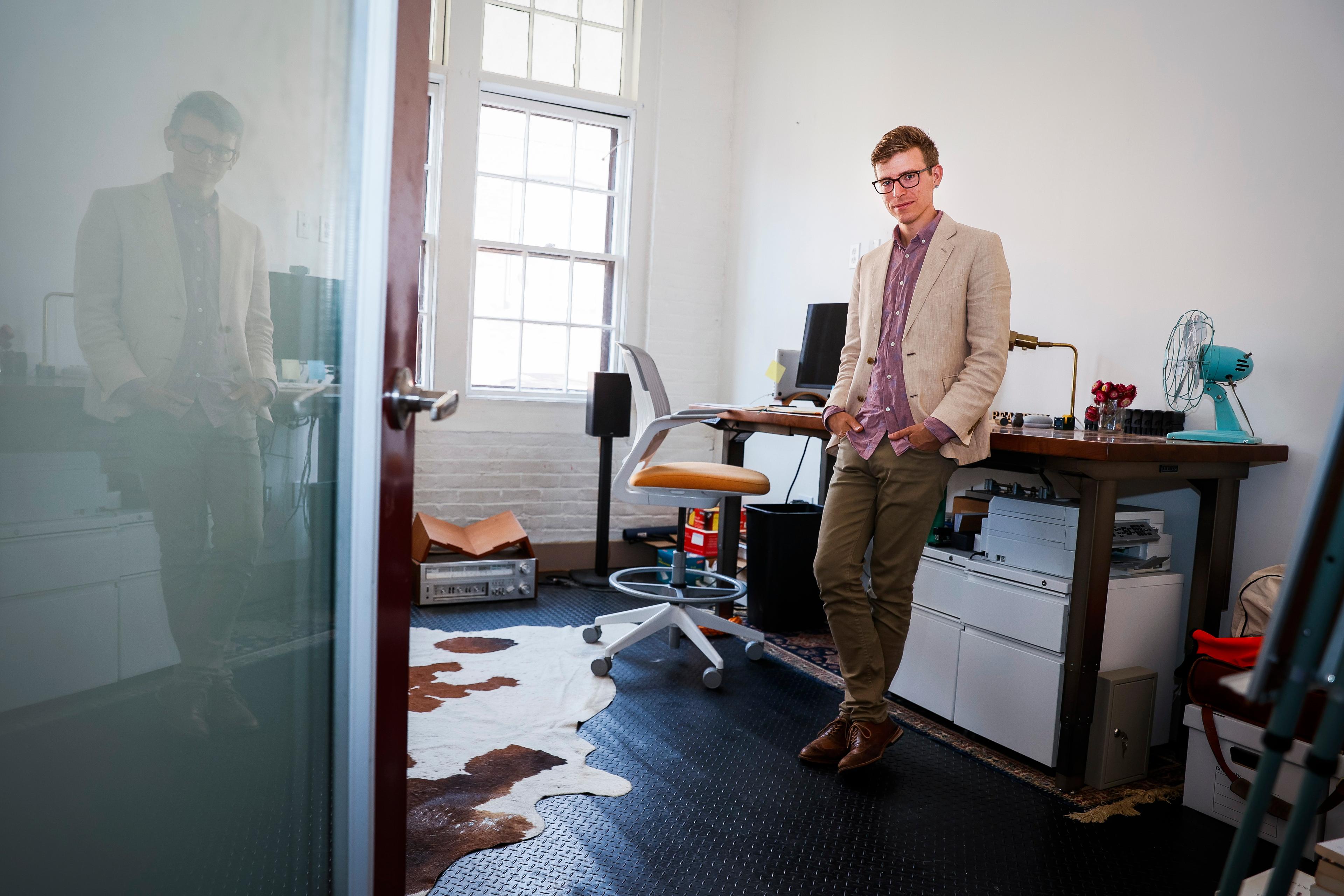
By Erin Clark for Commonplace
What are some challenges that you face as you work to execute on this unique mission and vision? Do any of those challenges pertain specifically to project financing?
The first thing that comes to mind is actually several different challenges that I would group together under the umbrella of regulatory issues. Projects take a long time at the best of times, but when you add in so many voices – all of which are necessary for the process – along with many scarce, competitive funding sources, timelines can become very prolonged. For example, even though housing costs are a big, big issue in Greater Boston, there are still many restrictive zoning regulations in place in many cities and towns. These are hyper-local processes that take a really long time to get through, take even longer to change, and ultimately produce relatively few units of housing. Additionally, because you are developing income restricted property, you can't rely on rent increases to cover overages that you might incur during this protracted permitting period. That makes the tolerances pretty tight and it requires a great deal of patience and technical expertise to be able to manage the process and keep the project viable.
On the subject of project financing, the single biggest issue we face is access to pre-development funding. During pre-development, you have site control, but don't own the asset and therefore can't collateralize it, so you need to find the money to handle those critical activities needed to get a project going and, if applicable, to compete for state or federal funding.
"The problem is simply that there are never enough dollars to go around, even for affordable housing, which has well-worn pathways for funding, as well as quasi-public agencies and nonprofits working specifically to fill gaps left by the market. This acts as a limit on how many projects you can do and so, in terms of scaling our impact, sustainably solving for pre-development capital would be a massive breakthrough."
What types of solutions are you exploring for these challenges?
There's a great example in a partnership we have with a local health system, actually. Our partner thought to deploy some of their significant financial resources toward levers that affect the social determinants of health. One of those determinants is access to safe, healthy, and affordable housing, so we worked with our partner and a local nonprofit to secure pre-development funding at very favorable rates to produce extremely low-income supportive housing for the chronically homeless. With those funds secured, that project is now starting to move through the development process.
I think that was a very elegant solution because it addresses both their programmatic goals as a health system, while also providing low cost, patient pre-development funding for a project that needed to clear a ton of regulatory hurdles before construction. When it’s complete, we’ll have provided our community with a new development that properly meets the needs of a very vulnerable segment of the population and our community will have a greater capacity to serve that population outside of the hospital setting.
And more generally, public or quasi-public agencies can be a great source of pre-development funding; we’re actually originating a pre-development loan with a quasi-public in a town called Winchester in Greater Boston right now. The only catch is that everything has to fall neatly into the right buckets. So if, for example, you’re working on an affordable housing project that is predominantly LIHTC-funded and you’ve already crossed some of those initial hurdles and have minimized risks, then there are likely a lot of high-quality tools in the marketplace for you. Otherwise, it may be challenging to get a hold of pre-development funds using this approach.

By Erin Clark for Commonplace
You mentioned earlier that you’ve raised two funds to date. What can you tell me about those? Are you currently raising any funds and if so, how would those funds be deployed?
To clarify, the two funds I spoke about earlier were specific to the purchase or redevelopment of small multifamily properties. We currently raise funds from the private markets on a standalone basis for all of our projects that require private equity, rather than in a blind fund.
That said, I think there's an interesting thesis around raising a fund specifically focused on very tight geographic areas, like neighborhoods, to simultaneously develop multiple projects in one area. Going back to that idea about clustering our impact, I think this would be step two of that concept: considering ways to more efficiently capitalize when you’re trying to develop multiple housing or mixed-use properties, all within a very short walking distance to one another.
You and your partners managed to raise a $7 million fund right out of the starting gate. How did you manage that? Are there any lessons you may be able to share with others looking for the same success as they raise capital for their projects?
There are a couple of factors at play there. The first, which I really can't overstate enough, is the importance of having a strong anchor investor. Andrew’s family committed to anchoring the first investments in that fund, so that was a great endorsement of our vision.
Besides that, we purposefully sought out the longest-term stakeholders in the community, like nonprofits, endowments, and family foundations, and appealed to them specifically to contribute to their community through the renovation of historic triple-deckers that everyone in the area is familiar with. So much of the traditional real estate investment model is about having a fast turnaround, but we were pitching the exact opposite: buying into neighborhoods with the intent to potentially be a multi-decadal neighbor. Our thinking was that we could achieve better development outcomes by adopting longer investment horizons, rather than extracting value just a few years after the investment. That approach is much more in alignment with the kind of impact we want to have in a community and I think it was really just a matter of packaging that story and shifting the way we were looking for capital to match our investment philosophy.
Timing also played a key role. We went out to raise capital at a time when many people were trying to crack the code on how to opportunistically participate in the growth of Worcester. The city has been on an upward growth trajectory for the last decade or so and that has definitely contributed to the overall level of interest in investing in Worcester.
That experience really taught us a lot about raising capital and in particular about how to create desirability in a market that wasn't overtly desirable for more sophisticated capital sources. Instead of analyzing investments at the asset level, we were really taking the neighborhood as our unit of analysis; the idea being that there was a story to be told around clustering these kinds of high-impact redevelopment projects. Each individual project would modernize an existing home to make it more appropriate for the type of market demand in the area, and they would collectively contribute to a better neighborhood. And, as part of that process, we built our own construction and property management businesses to ensure high-quality execution of our strategy – you can sort of see how my earlier work for a scrappy, innovative multifamily developer informed this approach.
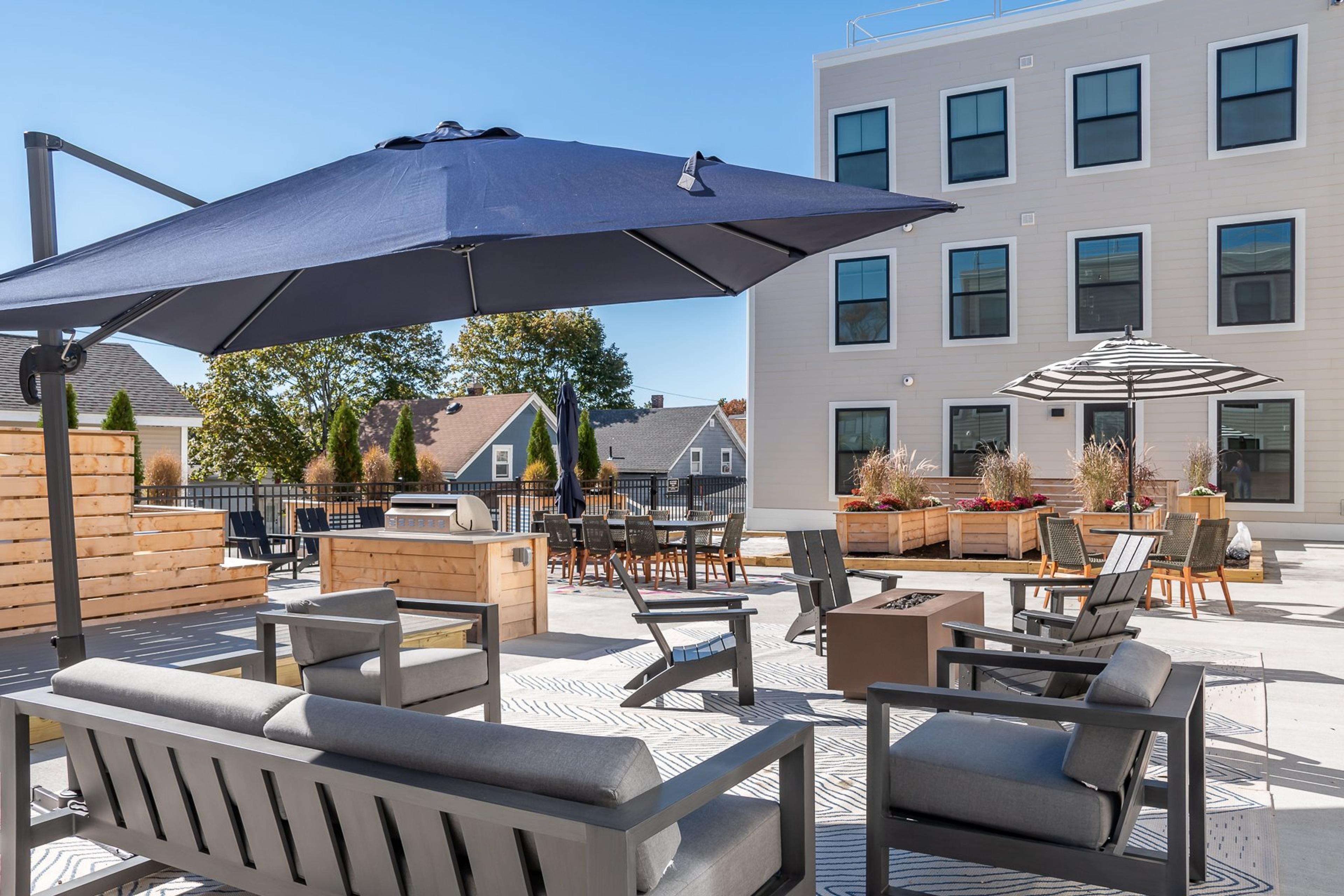
Ace Flats is a 55-unit mixed-income multifamily development in Reading, MA
Courtesy of Civico Development
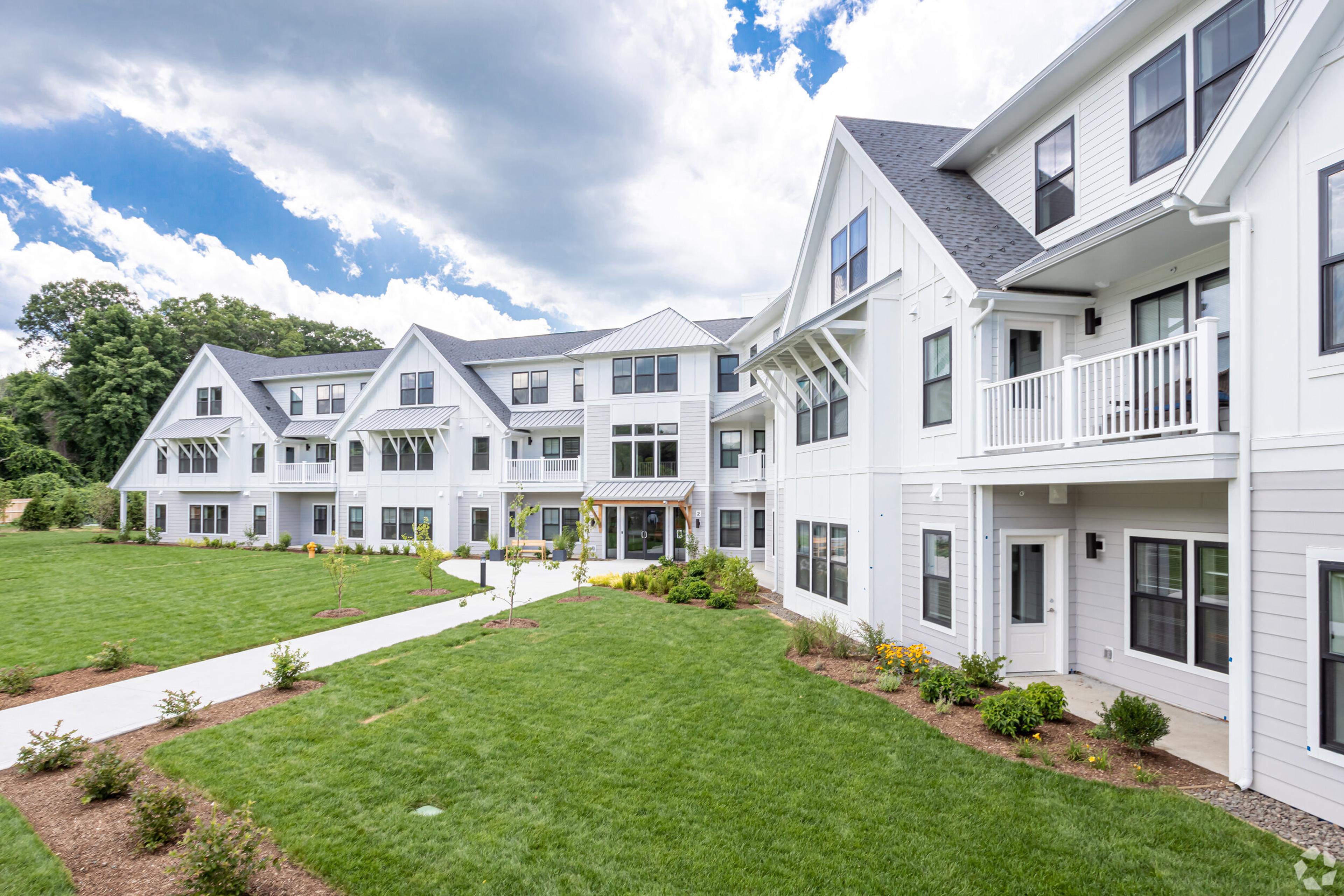
Oriole Landing is a multifamily development that was built in partnership with the Town of Lincoln, MA featuring 60 mixed-income housing units and a community garden
Courtesy of Civico Development
You mentioned that you started in property management, but it wasn't making the kind of impact you were looking for. What is that impact you are seeking and Is that something that you always want to do or is there something specific that inspired you?
I was actually really interested in finance at first. Maybe not in the traditional sense, but insofar as all real estate is married to finance. Which projects we develop are shaped in large part by the degree to which capital has an appetite to support them. To put it differently, I think a lot of practitioners of real estate think that they are the origin of what they're doing and why they’re doing it, but the reality is that there is a market that tells them what they can do well before they have the ability to exercise their creativity. And so, I was really interested conceptually in just this idea of how capital shapes society.
Overlaying that thought on top of my interest in real estate, I think a lot of the decisions that we make in development are antithetical to a lot of the values we hold as people and as a society. For example, it's quite easy to develop suburbanized infrastructure, even though we know that urban sprawl isn't conducive to health, wellness, and social bonds that keep us as humans happy. In that way, my specific interest in impact is an offshoot of my thinking about how everything is connected, just applied to my deals in the world of real estate.
That perspective couldn’t really be explored in property management because that’s really a service-based business that is pretty hard to embed with different values – at least until you reach a significant scale. Whereas in development, even though the bank and/or the investor may want you to reference a previous project as an example, there is enough latitude so that every project can be, say, 5% more innovative. In that case, after 10 projects you've actually deviated from the original model by 50%.
"I think a lot of the decisions that we make in development are antithetical to a lot of the values we hold as people and as a society. For example, it's quite easy to develop suburbanized infrastructure, even though we know that urban sprawl isn't conducive to health, wellness, and social bonds that keep us as humans happy."
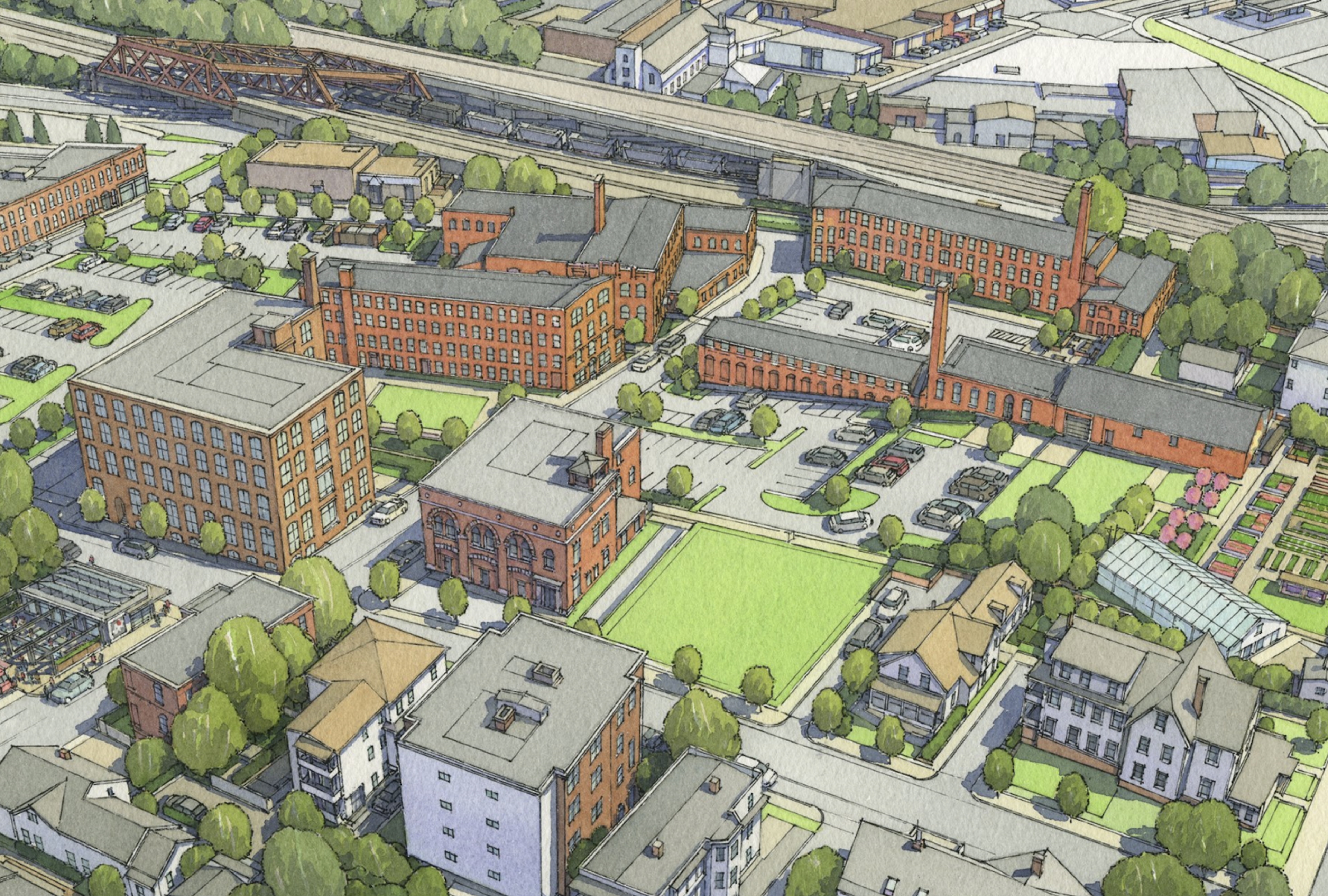
Concept art for the LaGrange Street Mill Complex redevelopment project
Courtesy of Civico Development

98 Beacon Street is one of the buildings at the LaGrange Street Mill Complex; it will have 55 units of mixed-income housing when rehabilitation is complete
By Erin Clark for Commonplace
What drives you and motivates you to do what you do?
Honestly, I’m still wondering about that myself! I've always been empowered to be a good citizen, which I think means different things to different people. For me, I feel it's a privilege to be alive here in the time in which I am; with all my friends, people, arts, culture, food – I mean, I just have always appreciated the act of living. And I think that appreciation motivates me to deploy the skills that I have, the best I can, to make the most of my time here.
By way of my circumstances and the things I've learned in life, it just so happens that I am, at the moment at least, adding or trying to add value in the world of real estate development in Greater Boston. As long as I can continue to add value and don't see myself as a hindrance, then I think I’ll just keep giving my best in this particular pursuit.
What are your thoughts about the tension between financial returns and social impact? Does it make it challenging to raise capital for these kinds of deals and do you have any advice for people trying to navigate this tension?
Well, people and/or the organizations and institutions they work for need to be compensated for their risk, so I definitely understand that concern. That said, I don’t feel there’s necessarily a tension in our work; I might understand having a hyperfocus on returns if there wasn’t a case to be made for any other value creation in our projects, but that’s just not the case for us. We have carved out a niche in a slightly different world that is all about aligning project goals to meet more than just a financial return, which therefore means that there are other, accepted ways of valuing a project. The term “triple bottom line” comes to mind, but it almost feels insufficient – it's really a function of how you frame the problem in the first place; we specifically choose to create and participate in these kinds of opportunities.
However, I do think that it's hard and we're still learning, so I don't have a conclusion on how best to navigate this space. One thing I could offer is that I have found it helpful to show how a particular vision is working in other contexts. And so, one of the things that I try to focus on is making sure there are clear precedents, either done by others or done by us, to help share the story and support the vision. I’ll also say that every day I'm looking for relationships to help ease the friction that you described so that I can get the right people to the table.
"If there's tension between return and the impact you’re seeking, I think there has probably been an inadequate articulation of how your work is additive across those other dimensions or an inadequate alignment among the people at the table. In my experience, when you get the right people to the table and you adequately articulate the goals that they are most concerned about, then everyone tends to roll in the same direction."

By Erin Clark for Commonplace
What is the role of government and policy in enabling the kind of impact you’re envisioning?
It’s clear that the government is an essential partner in everything that we do and that policy also lays the framework within which we all operate, whether you see it or you don't. So, going back to the root of Civico, I think it's our job to understand that and to participate where we can to maximize the impact within that given framework. And, if the framework doesn't work, then we have to find a way to participate in changing it and the government has to take the lead in implementing those positive changes.
One thing I’ll say is that I believe we should all seek greater efficiency when it comes to the deployment of scarce public resources and subsidies. Now, please don’t take that to mean that I begrudge anyone in the public sector – I’ve never worked in it and it’s probably a thankless job for many people. But I think people have been trying, probably since the dawn of the first public subsidies, to make it more efficient and that is the big issue that we all need to work out. Those dollars go to really important projects and if we had better, more efficient incentives, then we would be able to do more with each dollar and therefore increase our impact.
So, how exactly do we do that? I’ll let you know if I figure it out, but it’s obviously a complicated, multifaceted problem.

By Erin Clark for Commonplace
As you reflect on your career and company, are there things you wish you knew when you first started? What are some pieces of advice you’d offer to people looking to approach real estate the way that you have?
Oh, definitely – I can’t even enumerate them all here. But the first thing that comes to mind is: don't be afraid of collaboration – there's more than enough to go around. It’s like that old adage, “If you want to go fast, go alone. If you want to go far, go together.” This line of work really requires you to be in that latter camp.
And related to that, I think I was too impatient when I was younger; I wanted more, faster and that probably set me back. All of this stuff takes time. In real estate, or any industry really, if you’re trying to innovate and deviate even a little bit from the norm, it takes an enormous amount of time and effort. It’s not something that will happen overnight, so try not to push things as though they will happen overnight.
What legacy do you hope to leave?
In general, I would like to make it easier for people to go down the path I'm trying to go down by leaving behind a greater set of precedents around how development can be additive to our communities. That way, when the next person inevitably tries to do their version of that thing, it will be easier for them to innovate and move things forward.
One important underpinning of that is that I also don't want to do harm. Historically, the pursuit of urban development has in many cases done a lot of harm to a lot of people. And so, within my very, very small scope of impact, I want to do the best I can to contribute positively in an area I know has a fraught history.

Taylor Bearden
Civico Development
